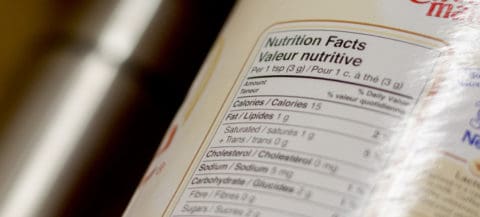Most packaged foods are required by federal law to include a regulated nutritional facts label, and while this is a valuable source of information, knowing the regulations that are not often stated is just as valuable.
For starters, did you know that the Calorie count used on nutritional labels is actually in kilocalories? Actual calories are one one-thousandth of the traditional Calorie used in nutritional labels. A tip for differentiating between the two is that calorie with a capital “C” denotes the use of kilocalories rather than calories.
The labelling standards in Canada are quite helpful for those looking to watch what’s inside the food they eat, and they provide an easy-to-read rundown of the Calories and nutrients found within their food. The labels provide a suggested serving size and must state the amount of Calories based on that serving.
Further down the label, there is more specific information on nutrients. This portion of the label is based upon 13 core nutrients, which include dietary fats, saturated and trans fats, cholesterol, sodium, carbohydrates, fibre, sugars, protein, vitamin A, vitamin C, calcium and iron. In addition to these 13 core nutrients, there are several other optional nutrients, such as folate, magnesium, potassium, and vitamins B12, B6, D and E, among others.
In addition to displaying whether the nutrient is present within the food, the labels also show an amount for each nutrient. Because the average person does not usually know how something like 220 milligrams of calcium relates to how much they should actually be taking in, daily value percentages are also included. An important fact to note is that all of these percentages are based on a 2,000-Calorie diet.

Nutrition facts labels allows those who are food quality conscious to get an overview of what their food contains.
This 2,000-Calorie-diet basis for nutrients is wholly inaccurate for males in general, from ages 19 to 30. Even at a low activity level, Health Canada recommends this cohort consume 2,500 Calories per day. At the highest activity level, 3,000 Calories are recommended, making these daily value percentages anywhere from 25 per cent to 50 per cent under what males from 19 to 30 are actually recommended to consume.
For females aged 19 to 30, the numbers are a bit closer to the mark, as the recommended Caloric intake for females at the lowest activity level is 1,900, reaching up to 2,350 at the higher activity level. In general, when looking at the recommended Caloric intakes for females at all ages past about 13 years old, the recommendations are close enough for the daily value percentages on nutrition labels to be useful.
However, after the age of 13, Health Canada recommends that men consume more than 2,000 Calories per day until they reach the age of 51 or older — thus, making these percentages, and the very popular idea of a 2,000-Calorie diet, completely useless to males for the majority of their lives.
In 2016, the Government of Canada mandated changes to food labels to better reflect how most Canadians eat and to highlight problem nutrients that Canadians struggle with. For example, the new label regulations mandate the addition of problem nutrients, such as a daily value percentage for sugars and sodium, while removing nutrients that are not problematic.
Some changes will also be organizational, with adjustments to the font size of Calories and serving size so as to better highlight these areas. The serving sizes themselves will also become more consistent across similar foods, making comparisons easier and more realistic, and reflecting the amount that Canadians eat in one sitting.
However, these changes, and others not stated here, do come as a five-year transitional period. So while these adjustments may be adopted in 2017, companies have until the end of 2021 to implement them. It is also worth noting that no change will be made to the use of the standardized 2,000-Calorie diet, so that must be kept in mind when using nutrition labels.
—
Jack Thompson / Staff Writer
Photo: Jeremy Britz / Photo Editor